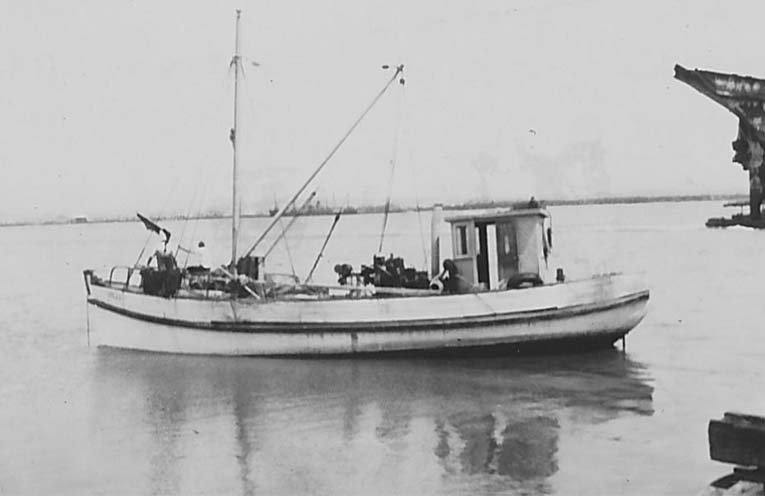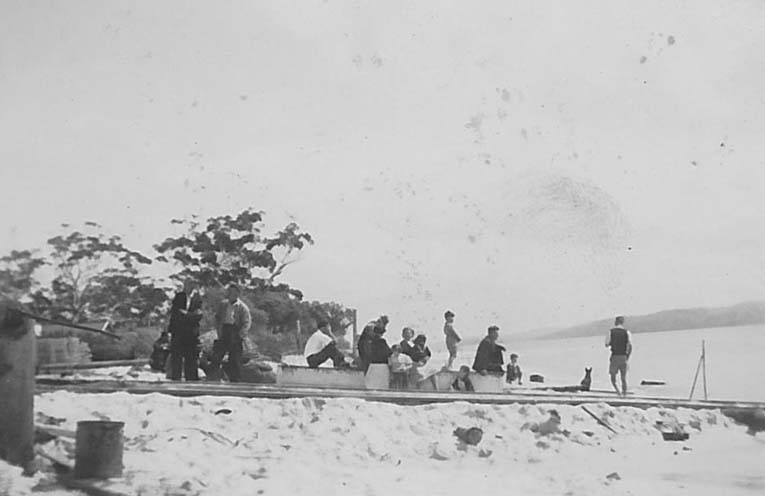
COLIN Mitchell, a farmer, arrived in Port Stephens in1910 and settled at Harris’s Farm, known today as One Mile Beach, where among his farming efforts, he attempted to raise draught horses.
The project was a failure and he died shortly after.
Two of Colin’s sons, Alf and Nelson, who married the Goddard sisters from Newcastle, Eileen and Sylvia, remained in the area and contributed significantly to the local fishing industry for many years.
Later the brothers were joined by their sons Colin, Clyde and Barry on board the trawlers ‘Eileen Sylvia’ and ‘Girl Pat’.
When Nelson’s first son was born the family lived in a bark house at Fishermans Bay before moving into a bag house on land owned by ‘Happy’ Jack Blanch at Boat Harbour.
The humpy, which provided shelter for Nelson, mum Sylvia, Nanna Mitchell and young Clyde, was burnt to the ground in a bushfire in 1936.
At Boat Harbour, Nelson worked the ‘IXL’, a sturdy boat nearly as wide as it was long.
Built out of New Zealand kauri, the boat, bought in Nelson Bay, was towed up to Salamander Bay on the first night, where it was moored.
Nelson’s wife Sylvia gathered the dry broad weed that was washed up on the bank and made a bed for the family to sleep on.
Later, when they moved up to Forster (Elizabeth Beach) to work, they took the boat up the Myall Lakes and moored it at Bungwahl, not far from Smiths Lake.
It was moored in the freshwater of the top lake as there are no borers, known as ‘cobra’, to attack the woodwork. When the lobsters were finished the men brought the boat back to Boat Harbour and pulled her up onto the beach, in front of Billy Richardson’s place, where they installed a Union 2 cylinder petrol kerosene engine.
Years later, in 1943, when Alf and Nelson decided to build the ‘Eileen Sylvia’ at Sandy Point they used the ‘IXL’ to take lobster pots out to Boulder Bay reef.
The lobsters that they caught, brought in enough money to keep them going while they continued to build.
Later, the brothers built the ‘Sandy M’.
Nelson’s nickname was Sandy.
The sturdy boat was a 20 footer with a 10 ft beam.
‘Sinker’ Morris , who lived and fished in and around Boat Harbour, ended up with the ‘Sandy M’ and spent some time prawning off Stockton.
Clyde Mitchell left school at fifteen years of age, allowing him to finally become what was always his calling – a professional fisherman.
The young fisherman worked the beaches – particularly 19 Mile Beach (Stockton or Long Beach) – for salmon, tailor, kingfish and mullet.
At this stage he lived at Sandy Point and travelled over to One Mile Beach and Boat Harbour where he set pots for lobsters and traps for fish, particularly snapper and leatherjacket.
Nelson and Alf were building the ‘Eileen Sylvia’ during this period.
Many of the old fishermen found time to keep neat, accurate diaries of their catches, financial records, balances and unusual events.
Some like Nelson Mitchell’s diary, which goes back to 1935, included a recipe for ginger beer and a list of presents for the family.
Other expenses incurred by Nelson were for benzine, trips on the punt, freight, tobacco, ice, potato sacks, calico, putty, tar, copper nails, a ball race, kerosene and a billy can.
Apart from repairs, parts for his boat and the essentials, meat and vegetables, there was money left at the end of 1936 for a grey frock, overcoat, petticoat, bloomers, brassiers and shoes, plus ten knitting needles.
On the income side the Mitchells depended entirely on what Nelson could return from the sea.
Sometimes the money was good, other times there was no money at all.
The diary tells of catches of leatherjacket, schnapper (all the old fishermen spelt snapper with a ch), mullet, jewfish, kingfish, tailor, blackfish, bream and garfish.
Lobsters contributed significantly, with the 1938 figures telling us that from the first pull on 27 July to 24 August, 275 dozen lobsters were lifted.
In 1941, 185 dozen lobsters were caught during the period.
At the time lobsters brought around 18/- a dozen or 1/6d each.
At today’s prices, around $80/kilo, one month’s wages would equate to approximately $250.000.00 – a quarter of a million dollars!
How times have changed.
By John ‘Stinker’ CLARKE

